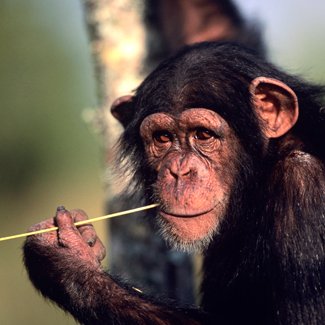Chimps are self-aware, says new research

CHIMPANZEES ARE SELF-AWARE and can anticipate the impact of their actions on the environment around them, an ability once thought to be uniquely human, according to a study released on Wednesday.
The findings, reported in the journal Proceedings of the Royal Society B, challenge assumptions about the boundary between human and non-human, and shed light on the evolutionary origins of consciousness, the researchers said.
Earlier research had demonstrated the capacity of several species of primates, as well as dolphins, to recognise themselves in a mirror, suggesting a fairly sophisticated sense of self.
The most common experiment consisted of marking an animal with paint in a place – such as the face – that it could only perceive while looking at its reflection. If the ape sought to touch or wipe off the mark from themselves while facing a mirror, it showed that the animal recognised itself.
Questioning the cognitive process of self-awareness
But even if this test revealed a certain degree self-awareness, many questions remained as to how animals were taking in the information. What, in other words, was the underlying cognitive process?
To probe further, Takaaki Kaneko and Masaki Tomonaga of the Primate Research Institute in Kyoto designed a series of three experiments to see if chimps, our closest genetic cousins, to some extent ‘think’ like humans when they perform certain tasks.
In the first experiment, three females initiated a video game by placing a finger on a touch-sensitive screen and then using a trackball, similar to a computer mouse, to move one of two cursors. The movement of the second cursor, designed to distract or confuse the chimps, was a recording of gestures made earlier by the same animal and set in motion by the computer.
The “game” ended when the animal hit a target, or after a certain lapse of time. At this point, the chimp had to identify with his finger which of the two cursors he had been manipulating, and received a reward if it chose correctly. All three animals scored above 90 per cent.
“This indicates that the chimpanzees were able to distinguish the cursor actions controlled by themselves from those caused by other factors, even when the physical properties of those actions were almost identical,” the researchers said.
But it was still not clear whether the good performance was truly due to the ability to discern “self-agency”, or to observing visual cues and clues – so the researchers devised another set of conditions.
Chimps as independent agents
This time they compared two tests. The first was the same as in the previous experiment.
In the second, however, both cursors moved independently of efforts to control them, one a repeat of movements the chimp had generated in an earlier exercise, and the other a repeat of an “decoy” cursor. The trackball, in essence, was unplugged, and had no connection to the screen.
If the animals performed well on the first test but poorly on the second, the scientists reasoned, it would suggest that they were not simply responding to visual properties but knew they were in charge.
The final experiment – used only for the most talented of the chimps – introduced a time delay between trackball and cursor, as if the two were out of sync, and a distortion in the direction the cursor moved on the screen.
All the results suggested that “chimpanzees and humans share fundamental cognitive processes underlying the sense of being an independent agent”, the researchers concluded.
“We provide the first behavioural evidence that chimpanzees can perform distinctions between self and other for external events on the basis of a self-monitoring process.”
RELATED STORIES

